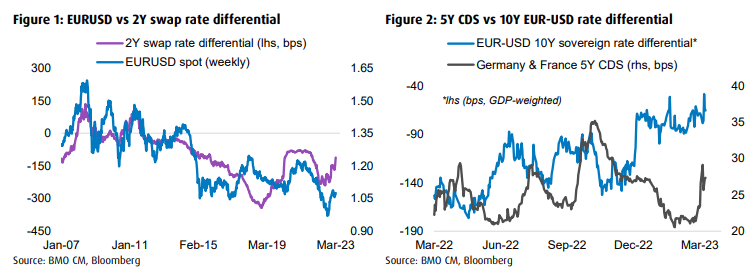EUR/USD Short-term Outlook Divides Opinion Among Strategists
- Written by: James Skinner
-
"It’s why we’re still long EUR/USD here (looking for 1.11 end Q2) and don’t see this morning’s price action as the start of a new trend" - Nomura.
 Image © European Union - European Parliament, Reproduced Under CC Licensing.
Image © European Union - European Parliament, Reproduced Under CC Licensing.
The Euro to Dollar exchange rate unwound a large portion of its earlier gains in the final session of the week as fresh selling of global banking stocks and related speculation divided strategists in their opinions about the short-term outlook for the single currency.
Europea's single currency remained one of the top perfomers in the G10 basket for the week on Friday even after sustaining last-minute losses against most counterparts including those in the broader G20 grouping of currencies amid another bonfire of banking shares.
"The “good news” from a Macro level is that in Europe G-SIBs [largest banks] are much more likely to have government involvement (bailouts if needed) than in the US for regional lenders (where congress will be hostile to the idea)," says Jordan Rochester, a strategist at Nomura.
"Still that doesn’t mean we can’t have a lot of mess in between and EUR/USD is ignoring rising rate spreads and instead tracking the banking index SX7E (it’s a fickle correlation though)," Rochester writes in a Friday research briefing.
Friday's prices action came as financial markets turned their attention toward a large German investment bank barely a week after speculation about the future of Credit Suisse led the Swiss government to force a merger with national rival and global competitor UBS.
 Above: Euro to Dollar rate shown at daily intervals with selected moving averages. Click image closer inspection.
Above: Euro to Dollar rate shown at daily intervals with selected moving averages. Click image closer inspection.
It also follows the failure of Silicon Valley Bank in the U.S., which led other firms into failure or distress last week while prompting investors, traders and analysts to ask questions about the stability and viability of other institutions in both North America and Europe.
"I would just argue there are problems in the US banking sector too and Fed pricing could keep EUR more supported than this morning’s sentiment thinks. US fiscal policy may be lacking, leaving more for the Fed on monetary policy to do down the line," Rochester says.
"It’s why we’re still long EUR/USD here (looking for 1.11 end Q2) and don’t see this morning’s price action as the start of a new trend," he adds.
Heavy selling of banking shares led to fresh losses for stock markets, declines across commodities and a rally in government bonds on Friday, all of which helped to drive what appeared to be a 'safe haven' bid for the U.S. Dollar at the expense of most other currencies.
But while Rochester and the Nomura team argue that the Euro should benefit from a less 'hawkish' Federal Reserve (Fed) interest rate stance and the prospect of the European Central Bank (ECB) continuing to raise borrowing costs, others have different views on the outlook for EUR/USD.
 Source: BMO Capital Markets. To optimise the timing of international payments you could consider setting a free FX rate alert here.
Source: BMO Capital Markets. To optimise the timing of international payments you could consider setting a free FX rate alert here.
"There is an argument for the EUR to retain a risk discount on the basis of this macro issue, and it implies that sustained gains in EURUSD above 1.08 will remain a near-term struggle," writes Stephen Gallo, a global FX strategist at BMO Capital Markets, in a Friday research briefing.
"I would remain a seller of the pair in the 1.08-1.10 range, with a clean break of 1.10 likely to require an extensive shift in the narrative. The nature of Euro
Area financial stress undermines the argument that EURUSD is a buy on the basis of interest rate convergence between the EUR and the USD," he adds.
Gallo argued on Friday that global market risk aversion would likely need to dissipate first in order for EUR/USD to benefit from a more favourable Transatlantic interest rate outlook, and warned of ongoing stability risks bubbling away in the background.
"The Euro Area has 20 individual nations, all sharing a common currency, but without a single EDIS or a fully centralized fiscal architecture serving as a backstop. Insured bank deposits in the Euro Area are expected to grow to €7-8 trillion in 2023," Gallo writes on Friday.
"If one national government is forced to step in with a full guarantee to halt a series of bank runs, what will stop a weaker sovereign issuer from doing the same? If panic ensues, bank bail-ins involving private creditors have the potential to morph into an existential crisis. Interestingly, a widening of sovereign CDS has coincided with a move higher in relative long-term Euro Area yields vs the US — the ultimate “haven” (Figure 2)," he adds.





